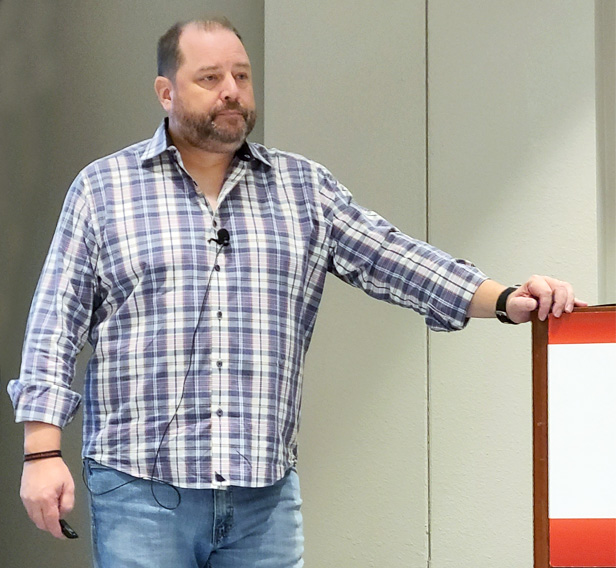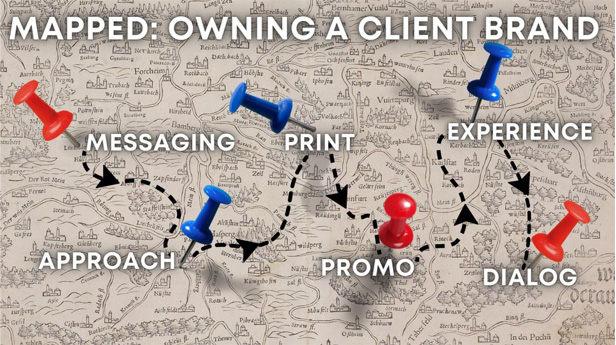July 26, 2023
ASI Chicago 2023: Own Your Client’s Brand To Build Your Business
Bill Petrie of marketing agency brandivate shared tips on how to separate yourself by focusing on every aspect of your clients’ branding and marketing efforts.
Owning a client’s brand is no simple process, but it’s essential if you want to build a lasting relationship and meaningful partnership with customers.
“There’s no easy button to success,” said Bill Petrie, founder and creative director of marketing agency brandivate.
Still, during a packed session on Education Day at ASI Show Chicago 2023, Petrie shared a roadmap to help promotional products distributors transition from “solution salespeople” to true “consultative salespeople.”

Bill Petrie, brandivate
Both solutions-oriented and consultative salespeople are devoted to solving a client’s problem, but focusing on products and immediate solutions alone “is not going to move the needle in a meaningful way,” Petrie explained.
“Your job isn’t to sell products. Your job is to sell purpose,” he said. “Stop thinking like a salesperson, and start thinking like a marketer.”
In order to do that, distributors must first define their audience. Everybody buys promotional products, but that doesn’t mean everyone is going to buy them from you, Petrie explained. He likened it to hamburgers. McDonald’s customers are looking for something quick, consistent and inexpensive, whereas patrons of, say, the Capital Grille are paying for a memorable experience. There’s nothing wrong with either business model, he added, but it’s important to know which you’re targeting.
Once you know your audience, you have to establish credibility with them. It could be as simple as tweaking your messaging to fit the client you’re talking to. Petrie gave the example of creating separate business cards for each of the markets you target. When you reach out to an insurance company, for example, you would give out the card that positions you as an “insurance marketing specialist.”
Finally, distributors should “take the unpaid job” of generating ideas for prospects and clients before they ask for them.
“You really need to understand your client’s brand before you start doing the unpaid work,” Petrie said. “You need to know their business almost as well as they do.”
Petrie outlined six areas for distributors to focus on as they map out a client’s brand and put together a marketing and merch strategy for them.

1. Messaging
It’s important to establish the goals a client has for its messaging – and how they’re going to measure whether those goals are reached. A distributor should “drive that discussion” and steer clients away from fantasy and toward reality, Petrie said. It’s all about managing expectations.
He suggested asking clients: “Why would your target audience choose to buy from you over your competition?” That, Petrie, said is the most fundamental question that any company should be able to answer immediately and it’s critical to help them accomplish their internal goals.
2. Approach
Next, find out how a client goes to market and reaches their own clients. Petrie suggested asking them: “What does your competition do that makes you insanely jealous?” This kind of question will help you understand how they view themselves in the marketplace.
3. Print
The average person sees a million pieces of digital data a day, which the vast majority are likely to go unnoticed, according to Petrie. “That’s why printed material still makes an impact,” he added. The quintessential example, he said, is the handwritten thank-you note, which is so much more meaningful than any emailed or texted note, however heartfelt it might be.
Though the promo industry has typically shied away from offering print services, Petrie believes it’s a huge missed opportunity. Whether it’s business cards, brochures, pamphlets or other printed material, distributors have the chance to help clients clarify their message and unify their branding.
Ask clients: “How will printed products increase engagement, tell your story, inspire the audience and move them to action?”
4. Promo
When it comes to branded merch, Petrie advised attendees to “slow down” and look at it from a different angle. “This form of marketing is amazing when done right,” Petrie said. “It’s also a disaster when done wrong.”
Don’t be afraid to say no to a client. Focus on thoughtfulness, usefulness and longevity. And look for ways to tie the mission of the company into the product.
Ask clients: “How do you want the branded merchandise to be used and remembered after delivery has been completed?”
5. Experience
Find out how the merch will be distributed. Are they giving the item out at a trade show? Will it be mailed directly to an end-user’s home? Is it part of a welcome kit for a new employee? Knowing the answer to such questions will help you guide clients toward creating the ideal immersive experience.
Back in the day, Petrie said, the only packaging that promo items received was individual polybagging. These days, however, the unboxing experience is nearly as important as what’s inside. Think about how your client’s merch will be presented. Will the box be printed? Will it be sealed with special tape? Consider senses beyond sight and touch – will there be a scent component? Will sounds play a role?
The biggest question to ask clients here is: “What is the overriding emotion you want your audience to feel when they see or think of your brand?”
6. Dialog
Once the product is delivered, it’s crucial to get feedback to understand what went well and what didn’t. Maintaining an open dialog with clients is critical for improvement.
Ask your clients, “How did we do?” but don’t accept “fine” as an answer, Petrie said. Let them know you’re looking for ways they can help you improve your service, and probe until you get an honest response. “This is how a partnership is built,” he added.
Changing the dynamic of your relationship with clients takes more work, but ultimately, “this is how you get a seat at the table,” Petrie said.
